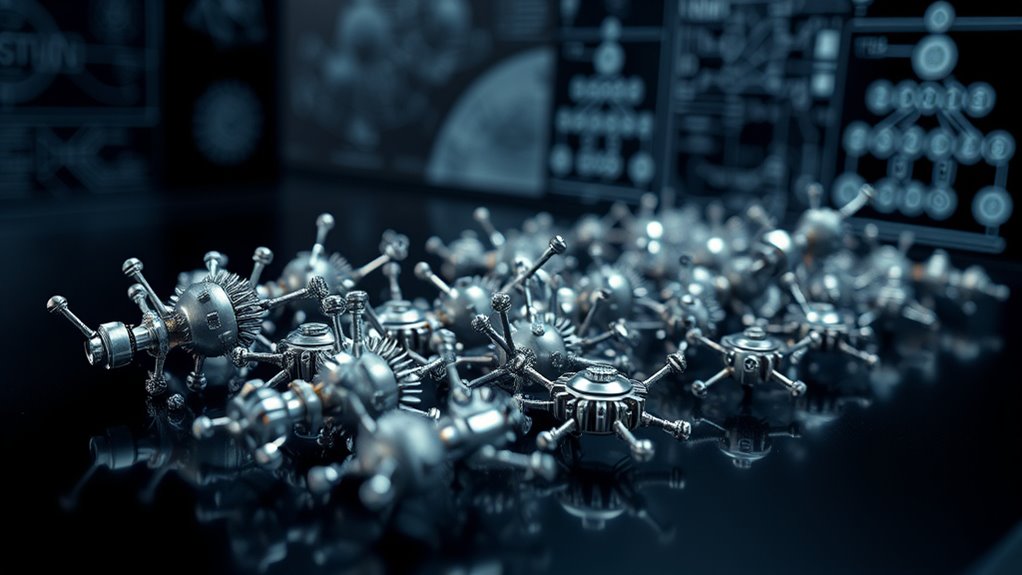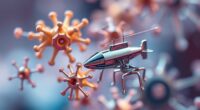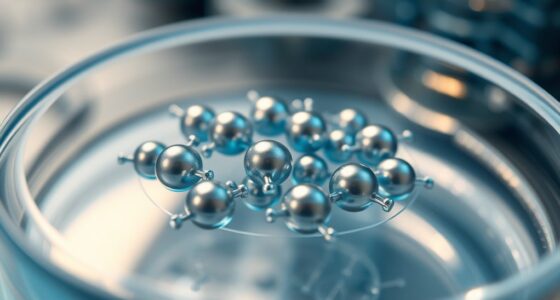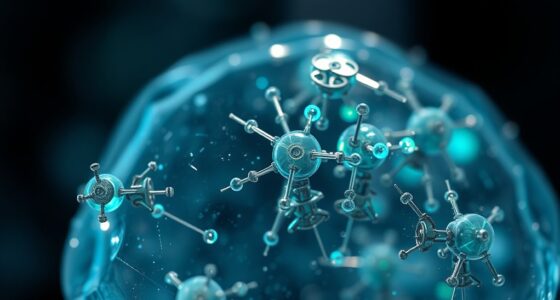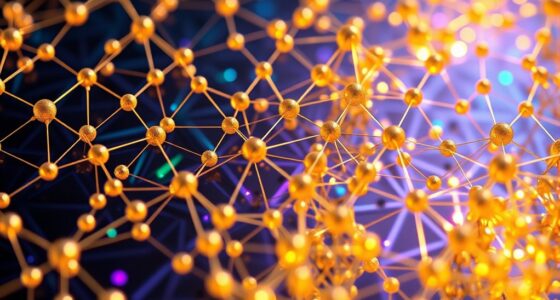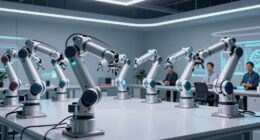The history of nanomachines begins with Richard Feynman’s 1959 lecture, where he envisioned manipulating individual molecules. Over time, advances in materials, molecular engineering, and fabrication techniques like atomic layer deposition and electron beam lithography turned those ideas into reality. Today, nanomachines perform precise tasks in medicine, manufacturing, and environmental cleanup. If you continue exploring, you’ll discover how these innovations keep pushing boundaries and shaping the future of nanotechnology.
Key Takeaways
- Richard Feynman’s 1959 lecture envisioned manipulating individual molecules, inspiring foundational ideas for nanotechnology.
- Early 20th-century scientists like Zsigmondy introduced concepts of atomic control and molecular interactions.
- Techniques such as chemical vapor deposition and molecular beam epitaxy enabled layer-by-layer nanomaterial fabrication.
- Advances in materials science and molecular engineering led to the development of functional nanodevices and self-assembly methods.
- Modern research focuses on creating precise, autonomous nanomachines for applications in medicine, manufacturing, and environmental management.
Early Inspirations and Theoretical Foundations
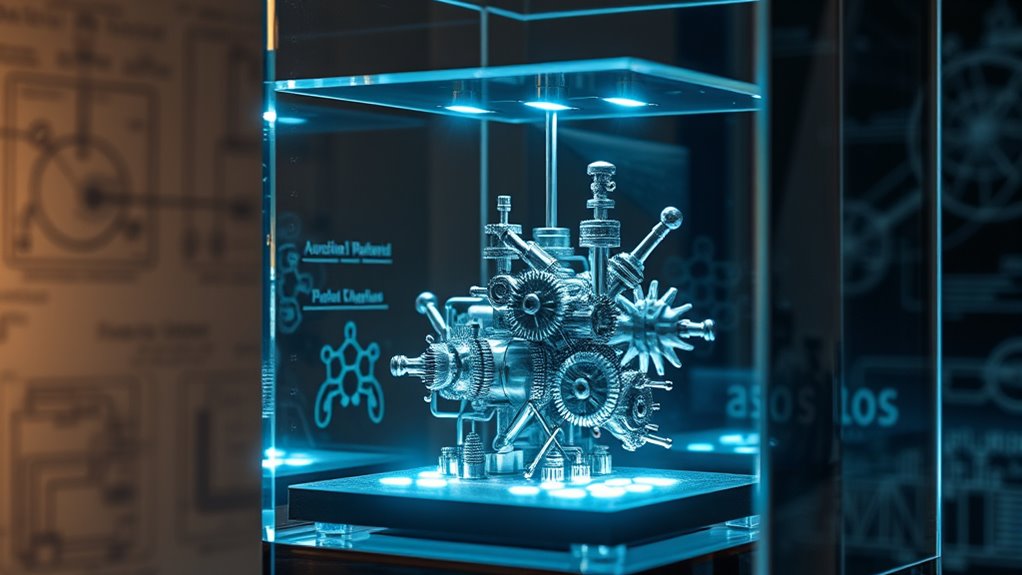
The concept of nanomachines draws its roots from early scientific ideas about manipulating matter at an atomic scale, which laid the groundwork for future innovations. Back in the early 20th century, scientists began exploring the possibilities of controlling individual atoms and molecules. These ideas were fueled by advancements in chemistry and physics, such as the development of atomic models and molecular structures. Pioneers like Richard Zsigmondy and other early researchers envisioned precise control at nanoscale levels. Theoretical frameworks emerged that suggested tiny machines could someday perform specific tasks by interacting directly with matter at an atomic or molecular level. These foundational concepts sparked imaginations and set the stage for future technological breakthroughs in nanotechnology and nanomachines.
Richard Feynman’s Pioneering Lecture and Its Impacts
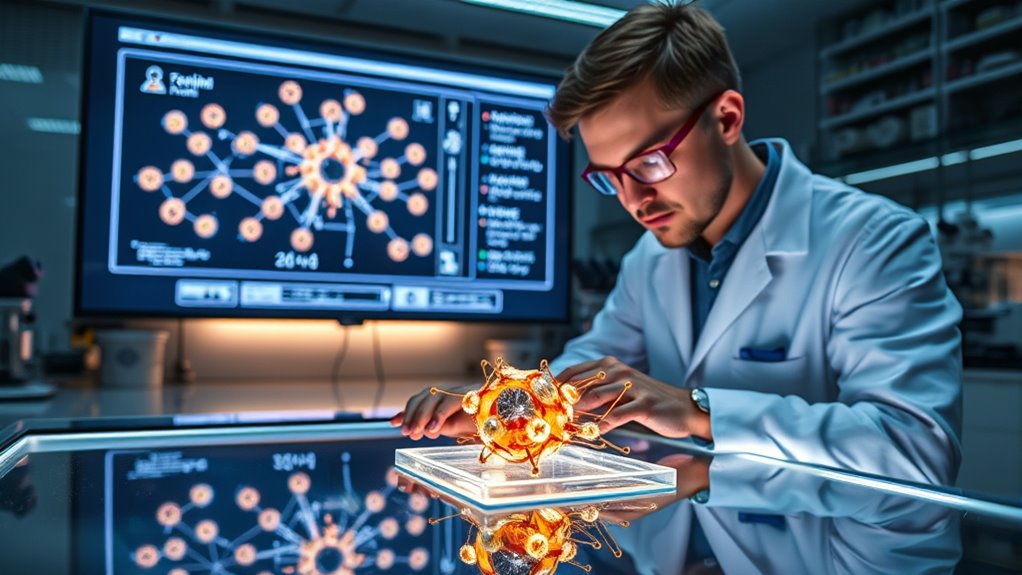
Richard Feynman’s lecture in 1959 sparked new ideas about manipulating matter at the atomic level. His visionary proposal laid the groundwork for modern nanotechnology and inspired scientists to pursue atomic-scale engineering. Today, his influence is evident in how nanomachines continue to advance and transform technology. The development of high-precision tools has been crucial in making these tiny machines a reality.
Feynman’s Visionary Proposal
In 1959, a visionary lecture by Richard Feynman ignited the imagination of scientists and engineers worldwide, laying the groundwork for the concept of nanomachines. Feynman envisioned a future where tiny devices could manipulate individual atoms, revolutionizing technology. His proposal included ideas like:
- Building machines at a microscopic scale, capable of precise assembly
- Using these nanomachines to repair cells and materials at the atomic level
- Achieving unprecedented control over matter, transforming industries
- The discussion of nanotechnology as a multidisciplinary field further propelled research into manipulating matter at the smallest scales, inspiring generations to explore the possibilities of nanomachines.
Influence on Nanotech Development
Feynman’s 1959 lecture sparked a revolution in how scientists and engineers approach the manipulation of matter at the atomic level. It inspired researchers to see the potential of building machines at nanometer scales, sparking new ideas and research directions. His vision motivated the development of tools like scanning tunneling microscopes and atomic force microscopes, which allow precise control and observation of individual atoms. The lecture also encouraged interdisciplinary collaboration, blending physics, chemistry, and engineering. Today, Feynman’s insights continue to influence innovations in nanomedicine, electronics, and materials science. His pioneering ideas laid the conceptual foundation for the rapid progress in nanotechnology, proving that what once seemed impossible is now a thriving field shaping the future.
Progress in Materials and Molecular Engineering
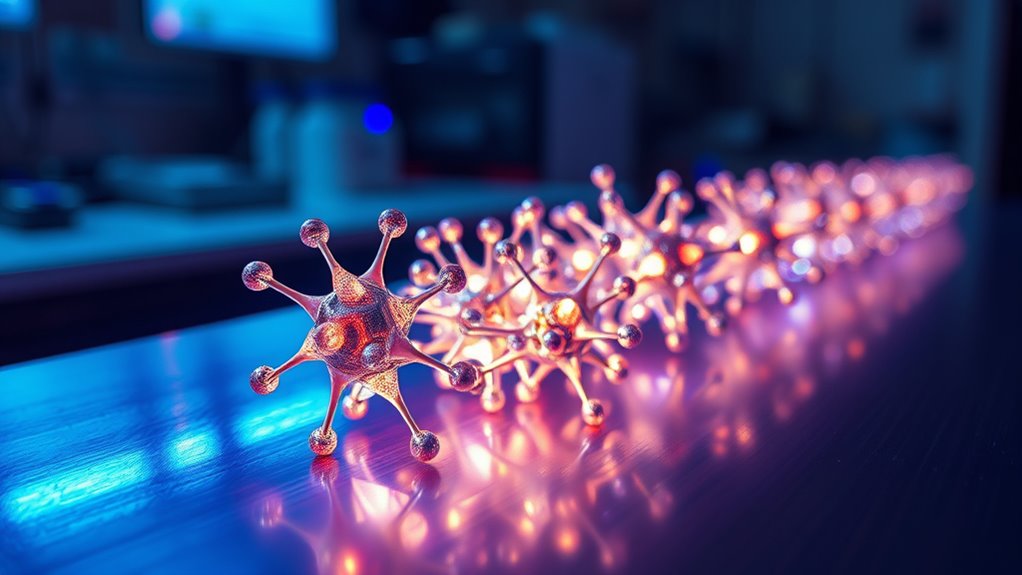
Advances in materials and molecular engineering have markedly propelled the development of nanomachines, enabling you to manipulate matter at an atomic and molecular level with unprecedented precision. This progress allows for creating components that are stronger, more flexible, and highly functional. You can now design materials with tailored properties, such as self-healing capabilities or enhanced conductivity. Imagine:
Advances in materials enable precise, self-healing, high-performance nanomachines with tailored properties.
- Molecules arranged precisely to create ultra-strong, lightweight frameworks.
- Synthetic polymers engineered for specific responses to environmental stimuli.
- Functional nanomaterials that can self-assemble into complex structures or repair themselves.
These innovations empower you to develop more efficient, adaptable nanomachines, pushing the boundaries of what’s possible in nanotechnology. The ongoing progress in materials and molecular engineering continues to shape the future of nanoscale devices.
Breakthroughs in Nanofabrication Techniques
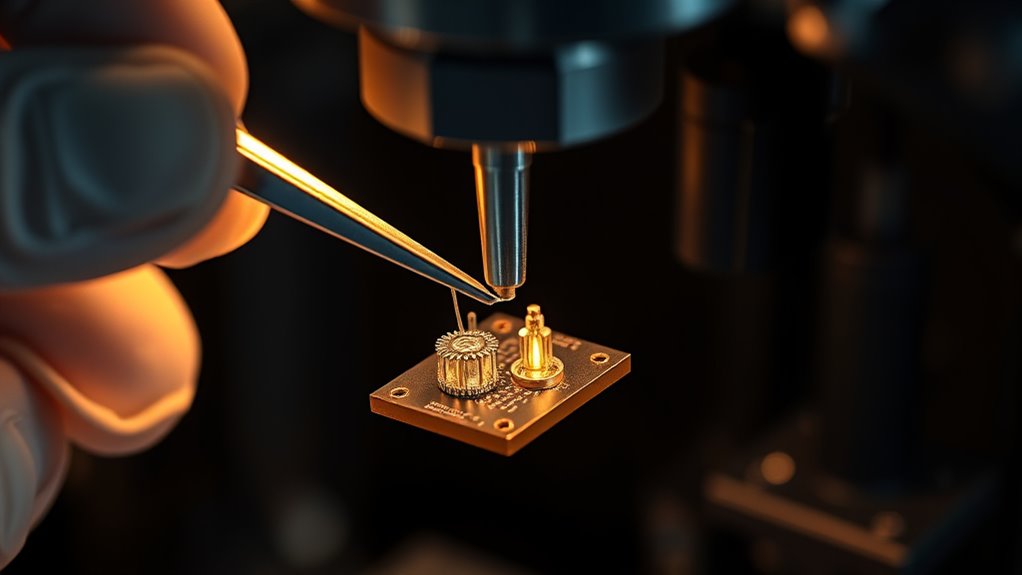
Recent breakthroughs in nanofabrication techniques have revolutionized how you build structures at the atomic scale, enabling unprecedented control over material placement and architecture. Techniques like electron beam lithography, atomic layer deposition, and focused ion beam milling allow precise manipulation of materials at nanometer resolutions. These methods have reduced the gap between design and realization, making it possible to create complex, functional nanostructures with high accuracy. Self-assembly processes, driven by chemical and physical forces, now enable you to organize molecules into desired patterns without direct manipulation. Additionally, advances in scanning probe microscopy provide real-time imaging and even manipulation of individual atoms and molecules, pushing the boundaries of what’s possible in nanofabrication. The integration of advanced characterization tools further enhances precision and quality control in nanomanufacturing, paving the way for sophisticated nanomachines and their diverse applications. Together, these innovations lay a solid foundation for future nanomachines and their applications.
The Emergence of Functional Nanomachines
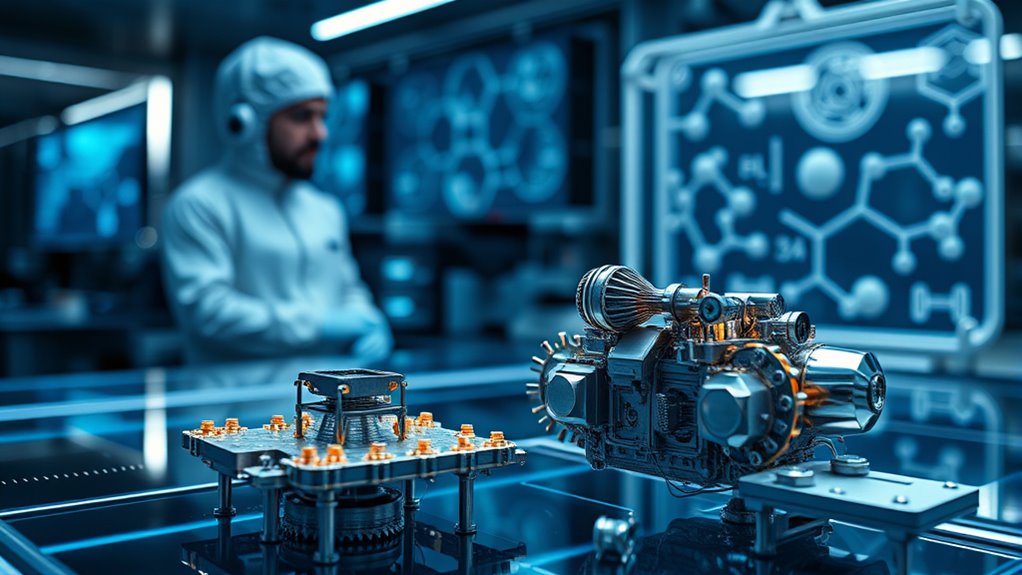
You see how early design ideas laid the groundwork for creating functional nanomachines, pushing beyond simple structures. Modern fabrication techniques now enable precise assembly of tiny components, making complex functions possible. Together, these advances mark the true emergence of nanomachines that can perform specific tasks at the molecular level. Maximize space and organization techniques also support the development of more efficient and adaptable nanomachines by providing insights into effective arrangement and functionality at the nanoscale.
Early Design Concepts
The emergence of functional nanomachines can be traced back to early design concepts that aimed to mimic biological processes at a microscopic scale. You begin to envision tiny devices capable of movement, manipulation, or sensing within cells. These ideas inspired researchers to think beyond traditional engineering, focusing on nature-inspired mechanisms. Imagine:
- Molecular gears rotating smoothly, transferring energy at the nanoscale.
- Biological motors like kinesin, walking along microtubules to transport cargo.
- Synthetic molecules that change shape or position in response to stimuli, acting as switches or valves.
- The development of molecular machinery that could perform complex tasks at the nanoscale, advancing the field of nanotechnology.
These concepts laid the groundwork for future innovations. They sparked curiosity about creating machines that could operate inside living organisms, leading to the development of more sophisticated nanodevices. Your focus shifts from macroscopic machinery to the microscopic domain of functional nanotechnology.
Contemporary Fabrication Techniques
Building on earlier ideas inspired by biological systems, scientists have developed advanced fabrication techniques to construct functional nanomachines with greater precision. Techniques like electron beam lithography allow you to pattern structures at the atomic scale, enabling the creation of intricate devices. Atomic force microscopy (AFM) not only images surfaces but also manipulates individual molecules, giving you direct control over nanoscale assembly. Self-assembly processes harness molecular interactions to form complex structures automatically, reducing fabrication complexity. Additionally, chemical vapor deposition (CVD) and molecular beam epitaxy (MBE) enable you to grow highly pure nanomaterials layer by layer. These methods collectively push the boundaries of what’s possible, allowing you to design and produce nanomachines with specific functions — from targeted drug delivery to nanoscale sensors. Hours Today List help ensure that research facilities operate on schedule, facilitating timely experimentation and development.
Current Applications and Technological Challenges
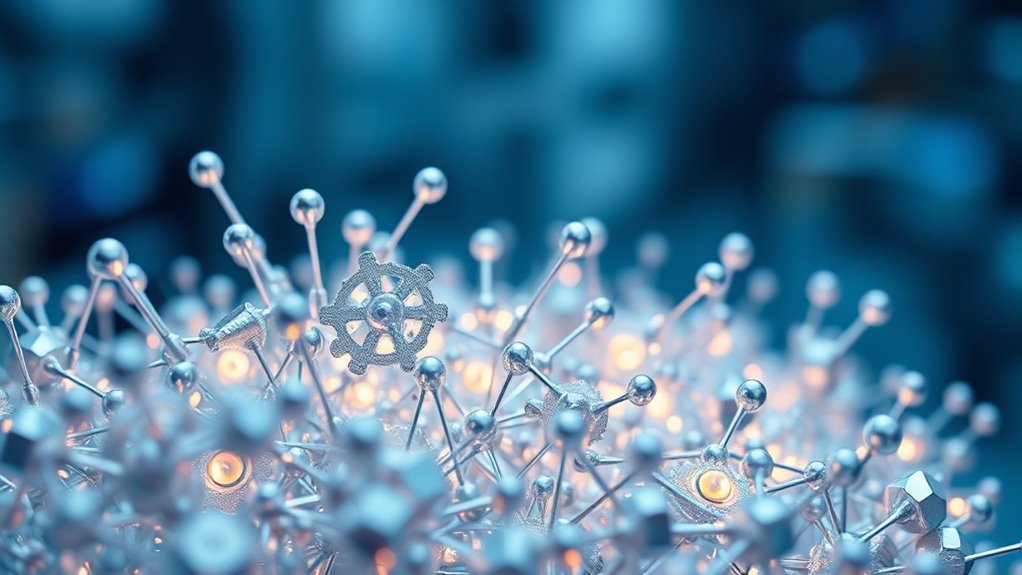
Despite significant advancements, nanomachines still face numerous technological hurdles that limit their current applications. You might imagine tiny devices guiding your bloodstream, repairing cells, or delivering drugs precisely where needed. However, challenges such as controlling movement, ensuring stability, and scaling production remain. These obstacles hinder widespread use and practical implementation. Additionally, researchers must address emerging trends in nanoscience to develop innovative solutions for these issues. Some key challenges include: 1. Precise manipulation at the molecular level, like steering a tiny boat through complex environments. 2. Maintaining stability and functionality in dynamic biological conditions, akin to a delicate instrument working flawlessly amidst chaos. 3. Developing scalable, cost-effective manufacturing methods to produce these devices reliably and in large quantities. Overcoming these challenges is vital for turning nanomachines from experimental tools into everyday technology.
Future Directions and the Next Frontier
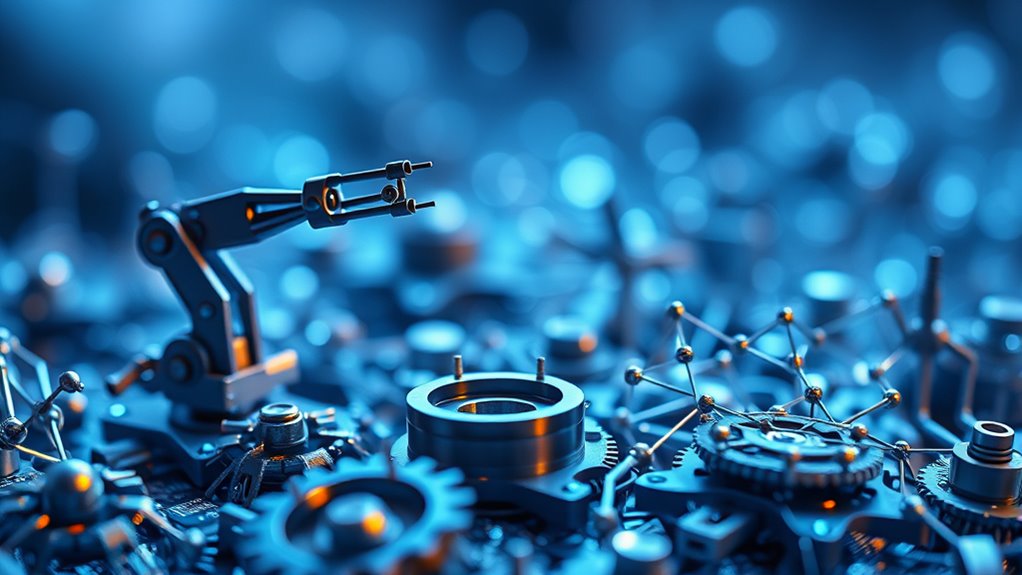
As nanotechnology continues to evolve, the future of nanomachines holds immense promise for transforming medicine, manufacturing, and environmental management. You’ll see advancements in targeted drug delivery, enabling treatments that precisely reach affected cells with minimal side effects. Manufacturing could become more efficient through self-assembling nanodevices that build complex structures atom-by-atom. Environmental applications might include nanosensors that detect pollutants early and nanomaterials that clean up toxins automatically. The next frontier involves integrating artificial intelligence with nanomachines, creating autonomous systems capable of decision-making and adaptation. As research progresses, ethical considerations and safety protocols will need to keep pace to guarantee responsible development. Additionally, innovations in Honda Tuning demonstrate how precise control and customization have evolved in automotive engineering, which could inspire more sophisticated nanomachine applications. Ultimately, you’ll witness a future where nanomachines become seamless extensions of our technology, radically improving quality of life and sustainability.
Frequently Asked Questions
How Do Nanomachines Differ From Biological Molecular Machines?
Nanomachines differ from biological molecular machines mainly in their design and function. You’ll find nanomachines are often man-made, crafted to perform specific tasks, whereas biological molecular machines are naturally evolved to sustain life processes. Biological machines operate efficiently within cells, using biochemical energy, while nanomachines may rely on external power sources or synthetic mechanisms. This difference influences their complexity, adaptability, and potential applications in medicine and technology.
What Ethical Concerns Are Associated With Nanomachine Development?
You should consider that developing nanomachines raises ethical concerns like potential health risks, environmental impacts, and privacy issues. You might worry about misuse, such as creating harmful weapons or surveillance tools. There’s also the question of controlling and regulating their use responsibly. As you support innovation, remember to stay informed about these ethical challenges to ensure nanomachine technology benefits society without causing harm.
How Might Nanomachines Revolutionize Medicine and Healthcare?
You might see nanomachines revolutionize medicine and healthcare by targeting diseases at the cellular level, delivering drugs precisely where needed, and repairing tissues or even cells. They could enable early detection of illnesses, reduce side effects, and improve treatment outcomes. With such advancements, you’ll benefit from personalized, minimally invasive therapies that enhance recovery times and overall health, transforming how we prevent, diagnose, and treat medical conditions.
What Are the Environmental Impacts of Nanomachine Manufacturing?
You can’t judge a book by its cover, and that applies to nanomachine manufacturing too. It can produce environmental impacts like nanoparticle pollution, energy consumption, and waste. You should stay aware of potential risks to ecosystems and human health. Responsible manufacturing practices and regulations are essential to minimize harm, ensuring that progress doesn’t come at the environment’s expense. Careful oversight helps balance innovation with sustainability.
When Will Nanomachines Be Widely Available for Commercial Use?
Nanomachines will likely become commercially available within the next 10 to 20 years, as advancements in nanotechnology accelerate. You can expect them to be used in medicine, manufacturing, and environmental cleanup, but widespread adoption depends on overcoming technical challenges and regulatory hurdles. Keep an eye on ongoing research and industry developments, because as innovation progresses, you’ll see these tiny machines integrated into everyday life sooner than you might think.
Conclusion
As you explore the history of nanomachines, you’ll see how Feynman’s vision ignited a revolution that’s reshaping technology itself. From pioneering theories to cutting-edge applications, this field is advancing at a breathtaking pace—like a rocket breaking the sound barrier. While challenges remain, your curiosity fuels the journey forward. Keep pushing boundaries, because the future of nanomachines promises innovations so extraordinary, they might just redefine what’s possible in science and engineering.
